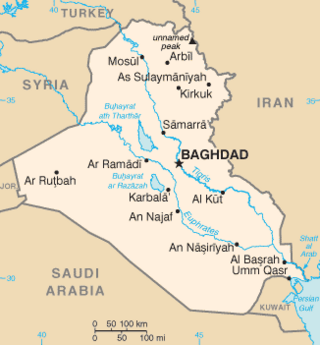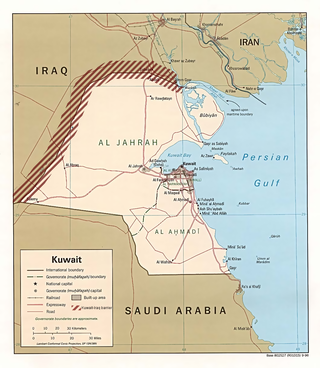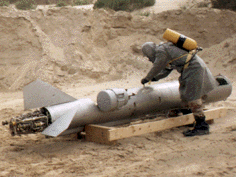The United Nations Iraq–Kuwait Observation Mission (UNIKOM) was established on April 9, 1991 following the Gulf War by Security Council Resolution 689 (1991) and fully deployed by early May 1991.

The Iraqi no-fly zones conflict was a low-level conflict in the two no-fly zones (NFZs) in Iraq that were proclaimed by the United States, United Kingdom, and France after the Gulf War of 1991. The United States stated that the NFZs were intended to protect the ethnic Kurdish minority in northern Iraq and Shiite Muslims in the south. Iraqi aircraft were forbidden from flying inside the zones. The policy was enforced by the United States and the United Kingdom until 2003, when it was rendered obsolete by the 2003 invasion of Iraq. French aircraft patrols also participated until France withdrew in 1996.

United Nations Security Council Resolution 687 was adopted on 3 April 1991. After reaffirming resolutions 660, 661, 662, 664, 665, 666, 667, 669, 670, 674, 677, 678 and 686 (1991), the Council set the terms, in a comprehensive resolution, with which Iraq was to comply after losing the Gulf War. Resolution 687 was passed by 12 votes to one (Cuba) against, with two abstentions from Ecuador and Yemen, after a very extended meeting. Iraq accepted the provisions of the resolution on 6 April 1991.

United Nations Security Council Resolution 678 was adopted on 29 November 1990. After reaffirming resolutions 660, 661, 662, 664, 665, 666, 667, 669, 670, 674 and 677, the council noted that despite all the United Nations efforts, Iraq continued to defy the Security Council.

United Nations Security Council resolution 1284, adopted on 17 December 1999, after recalling previous relevant resolutions on Iraq, including resolutions 661 (1990), 687 (1991), 699 (1991), 707 (1991), 715 (1991), 986 (1995), 1051 (1996), 1153 (1998), 1175 (1998), 1242 (1999) and 1266 (1999), the council established the United Nations Monitoring, Verification and Inspection Commission (UNMOVIC) to replace the United Nations Special Commission (UNSCOM). It was the final resolution adopted in 1999.

United Nations Security Council resolution 686 was adopted on 2 March 1991. After reaffirming resolutions 660, 661, 662, 664, 665, 666, 667, 669, 670, 674, 677 and 678, the council noted the suspension of international military action against Iraq and that all twelve previous resolutions continued to have full force and effect.

United Nations Security Council resolution 706 decided on a mechanism to allow Iraq to sell oil in return for humanitarian aid from Member States. The council, acting under Chapter VII, adopted the resolution on 15 August 1991, after recalling resolutions 661 (1990), 686 (1991), 687 (1991), 688 (1991), 692 (1991), 699 (1991) and 705 (1991). The provisions of Resolution 706 functioned in a way similar to that which was later implemented in the Oil-for-Food Programme under Resolution 986 in 1995.
The Geneva Peace Conference was held on January 9, 1991, in Geneva, Switzerland, to find a peaceful solution to the Iraqi occupation of Kuwait in order to avoid a war between Ba'athist Iraq and the United States-backed coalition. Iraqi Foreign Minister Tariq Aziz represented Iraq, while U.S. Secretary of State James Baker was the United States representative. Lasting nearly seven hours, both parties refused to move on their initial positions. Iraq refused to withdraw from Kuwait, while the United States and its allies continued to demand Iraq's immediate withdrawal. The meeting was the final initiative that eventually led to the Gulf War.

United Nations Security Council resolution 689, adopted unanimously on 9 April 1991, after recalling Resolution 687 (1991), the council noted a report by the Secretary-General and decided to establish the United Nations Iraq–Kuwait Observation Mission to monitor the demilitarized zone between Iraq and Kuwait, known as the Kuwait–Iraq barrier.

United Nations Security Council resolution 773, adopted on 26 August 1992, after recalling resolutions 687 (1991) and 689 (1991), the Council considered the work of the Iraq–Kuwait Boundary Demarcation Commission established on 2 May 1991, and reiterated its position that it would enforce any violation of the ceasefire in the demilitarised zone.

United Nations Security Council resolution 833, adopted unanimously on 27 May 1993, after recalling resolutions 687 (1991), 689 (1991), 773 (1992) and 806 (1993) in addition to a report by the Secretary-General Boutros Boutros-Ghali, the council noted the continuing work of the United Nations Iraq-Kuwait Boundary Demarcation Commission.

United Nations Security Council resolution 1051, adopted unanimously on 27 March 1996, after reaffirming resolutions 687 (1991), 707 (1991) and 715 (1991) on the monitoring of Iraq's weapons programme, the council approved a mechanism for monitoring Iraq's imports and exports of "dual use" items.

United Nations Security Council resolution 1060, adopted unanimously on 12 June 1996, after reaffirming resolutions 687 (1991), 707 (1991) and 715 (1991) on the monitoring of Iraq's weapons programme, the Council demanded that Iraq co-operate with weapons inspection teams from the United Nations Special Commission and allow unrestricted access to any areas and equipment the teams requested.

United Nations Security Council resolution 1115, adopted unanimously on 21 June 1997, after reaffirming resolutions 687 (1991), 707 (1991), 715 (1991) and 1060 (1996) on the monitoring of Iraq's weapons programme, the Council demanded that Iraq co-operate with weapons inspection teams from the United Nations Special Commission (UNSCOM) and allow unrestricted access to any areas and equipment the teams requested.

United Nations Security Council resolution 1134, adopted on 23 October 1997, after recalling resolutions 687 (1991), 707 (1991), 715 (1991), 1060 (1996) and 1115 (1997) on the monitoring of Iraq's weapons programme, the Council demanded that Iraq co-operate with weapons inspection teams from the United Nations Special Commission (UNSCOM) and expressed its intention to impose travel bans on Iraqi officials in the event of non-compliance.

United Nations Security Council resolution 1137, adopted unanimously on 12 November 1997, after reaffirming resolutions 687 (1991), 707 (1991), 715 (1991), 1060 (1996), 1115 (1997) and 1134 (1997) on the monitoring of Iraq's weapons programme, the Council imposed travel restrictions on Iraqi officials and members of the armed forces after non-compliance with the United Nations Special Commission (UNSCOM).

United Nations Security Council resolution 1194, adopted unanimously on 9 September 1998, after reaffirming resolutions 687 (1991), 707 (1991), 715 (1991), 1060 (1996), 1115 (1997) and 1154 (1998) concerning Iraq's weapons programme, the council condemned Iraq's decision to suspend co-operation with the United Nations Special Commission (UNSCOM) and the International Atomic Energy Agency (IAEA).
United Nations Security Council resolution 1490, adopted unanimously on 3 July 2003, after resolutions 687 (1991), 689 (1991), 806 (1993), 833 (1993) and 1483 (2003) on the situation between Iraq and Kuwait, the Council extended the mandate of the United Nations Iraq–Kuwait Observation Mission (UNIKOM) monitoring the mutual border for a final period until 6 October 2003.
The timeline of the Gulf War details the dates of the major events of the 1990–1991 war. It began with the Iraqi invasion of Kuwait on 2 August 1990 and ended with the Liberation of Kuwait by Coalition forces. Iraq subsequently agreed to the United Nations' demands on 28 February 1991. The ground war officially concluded with the signing of the armistice on 11 April 1991. However, the official end to Operation Desert Storm did not occur until sometime between 1996 - 1998. Major events in the aftermath include anti-Saddam Hussein uprisings in Iraq, massacres against the Kurds by the regime, Iraq formally recognizing the sovereignty of Kuwait in 1994, and eventually ending its cooperation with the United Nations Special Commission in 1998.











